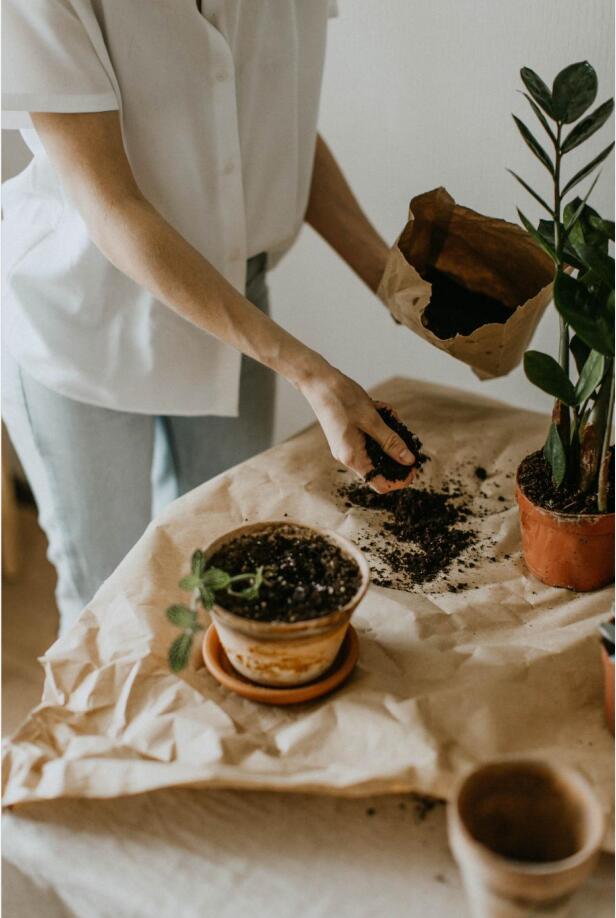As any parent will know, our children grow quickly and we have to resize their clothes all the time—this is the same for houseplants. As they grow you’ll have to repot your plants and give them a bigger container. Regular repotting will keep the plants healthy so knowing when and how to repot your houseplants, and, of course, how you need to prepare will make the process an easy one.
Different plants are more or less sensitive to repotting so make sure that you research whether their root systems are particularly delicate and what is the best way to repot for your particular plants.
Here are some broad signs that your little plants are ready to move to a bigger space:
-
The roots of plants are overgrown
When you see the roots of your plants growing out of the container’s drainage holes or growing up over the side of the pot, these are signs that your plants are ready for a bigger home.
-
A single massive root has grown
In a small pot, crowed roots will grow together and become rootbound. It is easy to confuse rootbound plants and underwatered plants because they have similar symptoms: yellow leaves and quick-drying soil. If your root system is no longer a collection of spidering strands and is instead a mass clump of roots, it is time to repot.
-
Slow plant growth
If your plants have been in the same pots for over a year and are showing no sign of growing larger keep an eye on your plants, maybe it is time to repot them.
-
New Plants
When you buy a new plant from the farmer’s market or the store it is not a bad idea to report it, because you have no idea how long it has been staying in its current home.
Choosing a Container-How to Repot Your Houseplants
When you’re looking for a container to repot your plants a bigger size is not always the right choice. One rule you must remember: never use a pot more than 2 inches larger in diameter than the size you’re using now. This rule stands because jumping up a pot size too quickly will mean that the roots will have a more difficult time soaking water since there is more space for the water to drain.
Another thing to look for when you choose a bigger pot is to make sure it has one or two drainage holes—if it does not your roots may rot because excessive moisture will create a perfect environment for mold, fungus, and pests.
So how do you report your houseplants? Before you report, prepare a large trash bag or a tarp since during the process things will get messy and it will be easier for you to clean up everything afterward. Here is a detailed breakdown of this process.

A step-by-step guide to repotting-How to Repot Your Houseplants
1. Prepare new soil for your new pot, do not use soil from an outdoor garden—it will be too dense and water cannot drain quickly enough. A high-quality potting mix will be better for your roots.
2. Put your old and new pot together, calculate how much taller the new one is, and then calculate the cubic footage of the soil space, then subtract the smaller amount from the larger one. This is the amount of soil you’ll put at the bottom of your new container. Lift your plant from your old pot gently, be aware of the roots and stems, and be sure not to break any of the roots.
3. As you move the plant from one pot to the other, dislodge the loose soil from the roots by massaging them gently. Gently separate any roots that have grown together. Insert your plant into the soil in the center of the pot. Pat the sides of the roots with more soil and evenly distribute soil around the plant and pack it somewhat tightly.
4. After you finish filling the soil, the last step is to give it a nice, long drink to your plant. Water will help the soil settle into place and it will relieve your stressed plant.
Signs your plant is unhappy in its new home-How to Repot Your Houseplants
Sometimes, repotting can be tricky—it does not always work out the way we hope. After repotting you may find that leaves are falling off, that they’re wilting, or that they are turning yellow. This is a common reaction to repotting since the process is extremely shocking to a plant. Don’t be nervous, this happens—plants will recover over time. If you didn’t break or destroy the root system the plants will recover.
Signs that your plant’s new home is too big-How to Repot Your Houseplants
The color of a healthy root system is usually somewhere between white to off-white. If you see your roots get slimy or there are dark-colored spots in the roots, you’re looking at rotten roots. It’s likely you’ve been overwatering and the plant is struggling to deal with mold and moisture, so cut back on the water.
To sum up How to Repot Your Houseplants
Knowing how to repot your houseplants is an important way to keep plants healthy. Keep in mind the tips and methods we mentioned above when you make your next repotting and do your best to be careful with your plants when you do.
If you have any questions, please don’t hesitate to reach out to us!
And be sure to check out our other blog posts for useful tips on becoming a great grower!
Subscribe to the VIVOSUN newsletter for growing tips, grower stories, and special offers, and get 12% off your first order!
We love the new VIVOSUN Smart Grow System and we are certain that you too will love it once you try it.
And join our Facebook farmer’s community for even more exclusive contests and prizes!
Download VIVOSUN App to get 18% off and explore more information!







